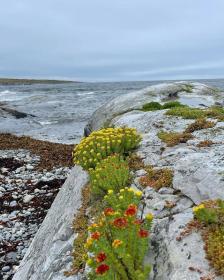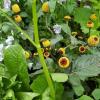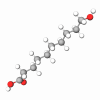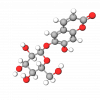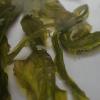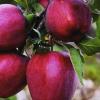Rhodiola rosea, also known as Arctic root or Golden root, is a member of the Crassulaceae family, a family of plants native to the Arctic regions of Eastern Siberia and grows at high altitudes. As an herb, it grows approximately 2½ feet high and has yellow flowers, whose aroma is similar to that of roses.
Rhodiola rosea is a robust plant that thrives in harsh conditions – cold, wind, drought, reduced oxygen, and intense radiation exposure. This survival capacity is termed adaptogenicity and may explain why extracts from this plant provide exceptional healing and protective powers.
Rhodiola Rosea Root Extract is a raw material derived from “Golden Root” to provide beneficial antioxidant and adaptogenic activity to the skin. It is an active extract, which, when applied to the skin in a cosmetic vehicle, will provide advanced antioxidant protection from environmental damage to help keep skin in peak condition, ward off the visible signs of aging, and allow the skin to easily adapt to internal and external stressors.
At a 1% use level, Rhodiola Rosea Root Extract has demonstrated thermal protection in human keratinocytes, at both hot and cold temperatures as well as stimulating oxygen respiration in nerve cells. A chemical study has shown that Rhodiola Rosea Root Extract is comparable to vitamin C as an antioxidant. Incorporation of this extract into skin care products offers formulators an exotic marketing story on an ingredient that has proven efficacy.History
According to recorded and published reports from 760 A.D., Rhodiola was first used by Tibetans to preserve body health and to treat diseases. As a traditional herbal remedy, Rhodiola has been used by Tibetans to clear heat in the lungs, eliminate poisonous substances from the body, and treat epidemic diseases, edema to the limbs, and traumatic injuries and burns.
For centuries, R. rosea has been used in the traditional medicine of Russia, Scandinavia, and other Eastern countries. Traditional folk medicine used R. rosea to increase physical endurance, work productivity, longevity, resistance to high altitude sickness, and to treat fatigue, depression, anemia, impotence, gastrointestinal ailments, infections, and nervous system disorders.
In mountain villages of Siberia, a bouquet of roots is still given to couples prior to marriage to enhance fertility and ensure the birth of healthy children. In Middle Asia, R. rosea tea was one of the most effective treatments for cold and flu during severe Asian winters.
Mongolian doctors prescribed Rhodiola Rosea root extract for tuberculosis and cancer. A recently published book, The Rhodiola Revolution, addresses the nutritional benefits of Rhodiola and suggests that this plant is poised to be a major new ingredient in the supplemental healthcare market.Research
Rhodiola rosea has been categorized as an “adaptogen” by researchers due to its observed ability to increase resistance to a variety of chemical, biological, and physical stressors. R. rosea is also rich in phenolic compounds, which are known to have strong antioxidant properties.
The investigation of the phytochemistry of R. rosea root has revealed the presence of six distinct groups of chemical compounds:
- Phenylpropanoids (rosavins),
- Phenylethanol derivatives (salidroside),
- Flavanoids,
- Monoterpenes,
- Triterpenes,
- Phenolic acids.
Although rosavins are now the accepted marker for genetically pure R. rosea (and its extracts), salidroside has historically been used as a chemical marker for this species. These compounds are not necessarily the only pharmacologically active ingredients responsible for the efficacy observed in clinical studies. In fact, precise identification of the compounds responsible for the numerous health benefits of R. rosea remains to be confirmed.
